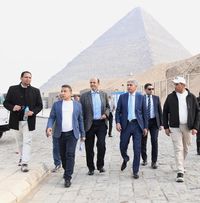In a significant move to enhance the visitor experience at one of the world's most iconic archaeological sites, the Giza Pyramids area has begun a new chapter with the launch of an experimental service development project. This initiative, which officially opened on April 8, 2025, is being closely monitored by Egypt's Minister of Tourism and Antiquities, Sherif Fathy, who is committed to ensuring a smooth transition and improved visitor services.
According to reports received by the minister from the ministry's monitoring team stationed at the archaeological site, the visitor flow has been efficient and well-organized since the project's inception. The ministry is now focused on addressing any challenges identified during the initial phase and is actively seeking solutions to enhance the overall tourist experience.
Dr. Mohamed Ismail Khaled, the Secretary-General of the Supreme Council of Antiquities, confirmed that on April 13, 2025, the Giza Pyramids area welcomed approximately 15,000 visitors, marking a 25% increase compared to the first day of the experimental operation. This surge in attendance reflects the public's eagerness to explore the enhanced services offered at the site.
"The movement of visitors has been notably smooth, whether entering through the Cairo-Fayoum gate or navigating the various pathways within the archaeological area," Dr. Khaled noted. He emphasized that the improvements made thus far have significantly contributed to a more enjoyable experience for both Egyptian and international tourists.
As part of the ongoing enhancements, two self-service machines for purchasing entry tickets have been installed at the Cairo-Fayoum entrance. This development aims to streamline the entry process, making it more convenient for visitors to access the site.
The project, implemented by Orascom Pyramids Services, is not only about improving services but also about learning from the operational experiences. The ministry is gathering feedback from tourists and workers to refine its approach and build on the positives identified during the trial period. This collaborative effort involves multiple governmental bodies to ensure that the Giza Pyramids area remains a top-tier tourist destination.
In addition to the ticketing improvements, the ministry has made several operational adjustments based on observations during the project's rollout. The transportation system within the site has been bolstered by utilizing diesel buses until the electric vehicles, which are part of the agreed plan, arrive. There is also a commitment to allow rapid tourist buses access to the archaeological area, enhancing accessibility for large groups.
Furthermore, the ministry has instructed the service provider to increase the seating capacity of its electric buses to 50 seats per vehicle, ensuring that more visitors can travel comfortably within the site. Security measures have also been enhanced to ensure the safety of all guests.
All these efforts are part of a broader strategy to improve the tourism experience in the Giza Pyramids area, which is recognized not only for its historical significance but also for its potential to contribute to Egypt's economy through tourism.
As the experimental phase continues, the ministry remains vigilant in monitoring visitor feedback and operational efficiency. The goal is clear: to create a world-class tourism experience that honors the rich history of the Giza Pyramids while providing modern conveniences.
With the successful implementation of these enhancements, the Giza Pyramids area is poised to become a model for tourism development in Egypt, showcasing how historical sites can evolve to meet contemporary visitor needs while preserving their cultural heritage.



